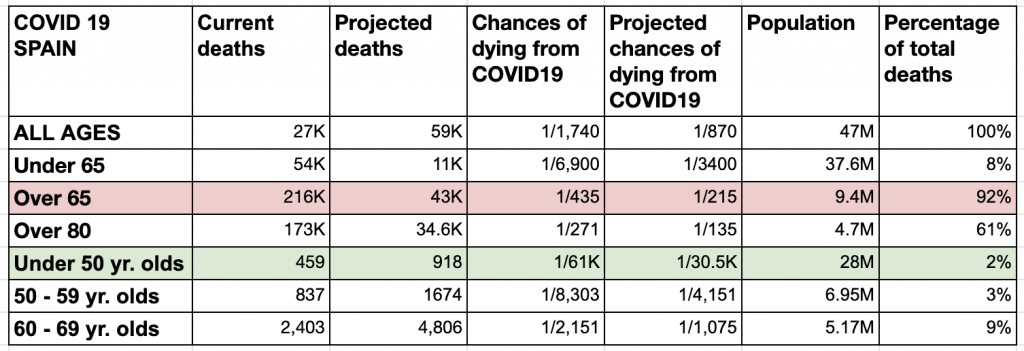2020 27
The Math of COVID19
Published by MartinVarsavsky.net in General with
https://www.youtube.com/watch?v=pyT932OLCfs

A demographic portrait of the pandemic
The chart above is an analysis of the mortality rates of COVID19 in Spain, demonstrating that mortality rates among those over 65 are much higher than for younger populations. These trends could be applied to any other country with the caveat that Spain has a high elderly population when compared to other countries (ranking third in Europe with regards to its elderly population, it is slightly below Italy and Greece) which is coupled with extensive intergeneration social contact. COVID19 fatalities are directly linked to the patient’s age and looking in detail at which age groups are most affected by the pandemic is imperative.
The total deaths in Spain from COVID19 are 27K and can be found in the first row. Government figures quote around 21K deaths, yet I have also added excess mortalities, which account for about 6K more deaths (for excess mortalities see Informe Momo). The official death counts and the total number of deaths are probably the result of limited testing for the virus rather than intentional undercounting (see Imperial College’s report on the number of infections). My estimate is that between now and until the end of the year, the number of total fatalities will double, with a total of 54K. These projected figures are obviously questionable, yet I find value in including not only real figures, but also a projection of how the pandemic could evolve.
In the second row are the statistics regarding people under 65 with 5.4K deaths and a total of projected deaths of about 11K. This translates to 1 in 690 people who have died already from the virus or 1 in 3.4K by the end of the year. The total population for this age group is 37.64 million yet this age group represents only 8% of the total COVID19 deaths.
In stark contrast, people over 65 years of age, make up 92% of the fatalities due to COVID19 and amount to a total of 9.4 million in Spain. This age group has disheartening rates: 1 in 435 have died by now and possibly 1 in 215 will die by the end of the year. When you narrow it down to people over 80, it is possible to see how incredibly lethal this virus is: those over 80 represent 60.4% of the deaths. However, there are only 4.7 million people in this age category in Spain, meaning that already 1 in 271 have died from coronavirus and around 1 in 135 will probably die by the end of the year, unless of course a vaccine is developed or a treatment is found, thus herd immunity would not have to be reached.
In terms of the impact of COVID on those under 50, it is an almost non-lethal virus and the fatalities in this age group represent only 1.7% of the total deaths. To better assess this percentage and get a better idea of what this means we must take into consideration that a person who is 35 years old has a chance of dying of 1 in 500 due to any cause between the ages of 35 and 36. The likelihood of dying from coronavirus for this age group is 1 in 61K which is statistically insignificant. By the end of the year, those under 50 will have a chance of dying from coronavirus of 1 in 30.5K. Essentially, the pandemic is a non-factor for people under 50 who amount to 28 million in Spain.
The age group comprised between the ages of 50 to 60 represent only 3.1% of the total COVID19 deaths, while for the age group between the ages of 60 to 70 the percentage of total deaths is 8.9%. The chances of dying from COVID19 for these age groups are insignificant when compared to the chances of dying from anything else.
Assessing the likelihood of dying from coronavirus and highlighting the high lethality of COVID-19 for older people is essential in order to decide the future steps to follow with regards to the pandemic.
Follow Martin Varsavsky on Twitter: twitter.com/martinvars





